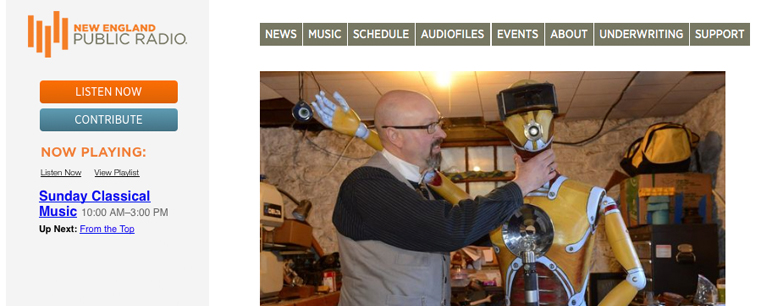

Let’s dial it back to 1870 for a moment, to the time when author Jules Verne left his mark with 20,000 Leagues Under the Sea. Verne wrote his classic science fiction novel years before it became a Walt Disney film. His submarine and high tech gadgetry were way ahead of their time, and they made a lasting impression.
Starting this week, over at the Springfield Museums, a group of artists is tipping their hats to him, and others from roughly the same era. Bruce Rosenbaum, who curated the exhibit, says he’s long had the idea of creating an exhibition focusing on iconic authors and inventors from the Victorian period.
“…these people changed the world,” Rosenbaum said.
Rosenbaum collects Victorian era and 20th century architectural salvaged materials and antiques. He’s used as much of this material as he could to make life human machines or “Humachines”
“The Humachines are full sized anthropomorphic functional sculptures,” Rosenbaum said. “They move, they light up, they have sound.” And he added, they’re made up of the objects that existed when these writer and thinkers were alive.
Jules Verne has been turned into “The Nautilus” the submarine he wrote about in 20,000 Leagues — one of his eyes, for instance, is an antique Victorian compass. H.G. Wells is at also at the museum. Rosenbaum turned him into the time machine Wells fictionalized. He’s a 19th century mannequin wearing welding goggles, surrounded by a dozen vintage clocks, each set at a different time. Every inch of Wells is adjacent to some vintage machinery or gadget, including an old barber chair from the 1800s, in which he sits. Rosenbaum says a missing part on the chair made for opportunity.
“I don’t know if you remember from the book or from the movie The Time Machine that Wells ends up traveling really far into the future by mistake? Wouldn’t it have been great,” Rosenbaum asked, “to have an emergency brake on his time machine?”
Rosenbaum pointed to where he attached a 1920s monkey wrench. Its red handle is easy to see, and grab in case you need to stop yourself from going too far into the future. As for how the time machine works. Rosenbaum turns it on.
“[First] it’s going through an activation, a start up process, and then everything turns on. Each of the Humachines that I did has an activation button. ”
The entire exhibit is in a Steampunk aesthetic. Rosenbaum says he loves the idea that Steampunk design is interactive by nature. He knows not everyone is familiar with Steampunk, and he’s often asked what it means. He put the definition it in math terms.
“Steampunk equals history plus art plus technology,” Rosenbaum said.
For all his love of old things, Bruce Rosenbaum is a modern man. By day he’s a marketing specialist who lives outside of Boston. But he is known in some circles as the godfather, the high priest, even the rabbi of Steampunk.
If you’re looking for it, Steampunk can be found in fashion, in video games, and in home design. Rosenbaum himself has Steampunked his smart phone case with a brass 1880s pressure gauge, and he cooks in a new electric oven housed in an old wood stove.
Here at the Springfield Museums, Steampunk is also embodied in Frankenstein writer Mary Shelley — who becomes the high voltage machine that brought the monster to life.
Rosenbaum said he found an “incredible 1800s mechanical dress form [for her body]. We used prosthetics for her arms.”
Shelley also has a plasma heart, Rosenbaum said. “It’s powered by 20,000 volts of electricity.” He posted a sign that says “Danger High Voltage,” and he added, “I kind of mean that.”
It’s a tall order, but according to Rosenbaum, the Humachines’ mission is to time travel into the present, to inspire the future of Springfield. He said it just made sense for the exhibit to be here, versus a modern museum in a city that’s buzzing along.
“Springfield is a place where there are a lot of people who want the city to get its mojo back!,” Rosenbaum said with a gust of enthusiasm.
At one time Springfield was a robust American city of firsts that buzzed with industry. Remember the emergency break / monkey wrench on H.G. Wells’ time machine? Made in Springfield.
